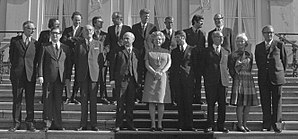
Back Den Uyl-kabinet Afrikaans Kabinett Den Uyl German Cabinet Den Uyl French Kabbinèt-Den Uyl LI Kabinet-Den Uyl Dutch
Den Uyl cabinet | |
|---|---|
55th Cabinet of the Netherlands | |
  The installation of the Den Uyl cabinet on 11 May 1973 | |
| Date formed | 11 May 1973 |
| Date dissolved | 19 December 1977 (Demissionary from 22 March 1977) |
| People and organisations | |
| Head of state | Queen Juliana |
| Head of government | Joop den Uyl |
| Deputy head of government | Dries van Agt (1973–1977) Gaius de Gaay Fortman (1977) |
| No. of ministers | 16 |
| Ministers removed | 3 |
| Total no. of members | 18 |
| Member party | Labour Party (PvdA) Catholic People's Party (KVP) Anti-Revolutionary Party (ARP) Political Party of Radicals (PPR) Democrats 66 (D'66) |
| Status in legislature | Centre-left Majority government (Grand coalition) |
| History | |
| Election | 1972 election |
| Outgoing election | 1977 election |
| Legislature terms | 1972–1977 |
| Incoming formation | 1972–1973 formation |
| Outgoing formation | 1977 formation |
| Predecessor | Second Biesheuvel cabinet |
| Successor | First Van Agt cabinet |
| Part of the Politics series |
![Azure, billetty Or a lion with a coronet Or armed and langued Gules holding in his dexter paw a sword Argent hilted Or and in the sinister paw seven arrows Argent pointed and bound together Or. [The seven arrows stand for the seven provinces of the Union of Utrecht.] The shield is crowned with the (Dutch) royal crown and supported by two lions Or armed and langued gules. They stand on a scroll Azure with the text (Or) "Je Maintiendrai" (French for "I will maintain".)](http://upload.wikimedia.org/wikipedia/commons/thumb/8/8f/State_coat_of_arms_of_the_Netherlands.svg/150px-State_coat_of_arms_of_the_Netherlands.svg.png) |
|---|
|
|
The Den Uyl cabinet was the executive branch of the Dutch Government from 11 May 1973 until 19 December 1977. The cabinet was formed by the social-democratic Labour Party (PvdA), the christian-democratic Catholic People's Party (KVP) and Anti-Revolutionary Party (ARP), the progressive Political Party of Radicals (PPR) and the social-liberal Democrats 66 (D'66) after the election of 1972. The cabinet was a Centre-left[1] grand coalition and had a substantial majority in the House of Representatives with Labour Leader Joop den Uyl serving as Prime Minister. Prominent Catholic politician Dries van Agt, the Minister of Justice from the previous cabinet, served as Deputy Prime Minister until his resignation. Prominent Protestant politician Gaius de Gaay Fortman the Minister of the Interior assumed the office of Deputy Prime Minister on 8 September 1977.
The cabinet served during the tumultuous 1970s and had to deal with several major crises such as the 1973 oil crisis, the Lockheed scandal, the Moluccans incidents and the fallout of the Yom Kippur War. Internally the cabinet suffered several conflicts, including the poor working relationship between Prime Minister Den Uyl and Deputy Prime Minister Van Agt, and multiple resignations. The cabinet fell on 22 March 1977, just before the end of its term, following a major political crisis, and continued in a demissionary capacity until it was replaced following the election of 1977.[2][3][4]
- ^ Changing Liaisons The Dynamics of Social Partnership in 20th Century West-European DemocraciesBy Karel Davids, 2007, P.165
- ^ (in Dutch) De mythe van het vechtkabinet van Joop den Uyl Archived 9 July 2016 at the Wayback Machine. University of Rotterdam. 2002
- ^ (in Dutch) Suèr, Henk. "Joop den Uyl: verguisd en inspirerend" (PDF). Archived from the original on 5 March 2012. Retrieved 17 April 2010.
{{cite web}}: CS1 maint: bot: original URL status unknown (link). roodkoper.nl - ^ "Onthullende biografie Joop den Uyl" (in Dutch). Archived from the original on 27 June 2009. Retrieved 17 April 2010.
{{cite web}}: CS1 maint: bot: original URL status unknown (link). University of Amsterdam. 21 February 2008